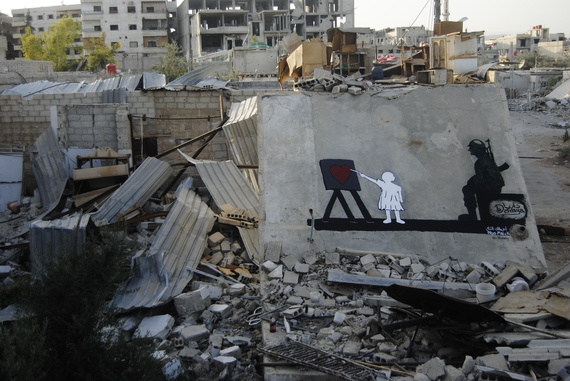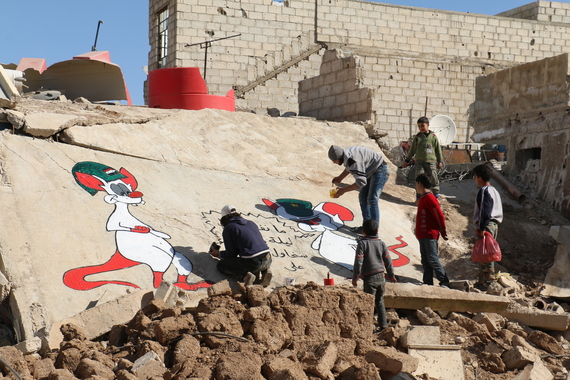The first of 26 graffitis Majd and Abu Malek put up on the walls of Darayya. Darayya 2014-2016. Photo: Darayya Media Center.
Darayya is a town in Syria, only 5 miles southwest of Damascus. The city was one of the first hotspots of the anti-Assad movement and its subsequent oppression by the regime. In August 2012, Assad's troops entered Darayya to commit the most horrific massacre the ٍSyrian Revolution had seen until then. What would later be known as the Massacre of Darayya was only the starting point of Darayya's destruction by continuous barrel bomb raids.
During the past five years, journalists and activists continuously have tried to report on the situation in Darayya. In life-endangering videos they have been documenting all of the regime's human rights violations including massacres, bombardments and the current siege.
The so-called "Darayya Media Center" is very active in covering the situation around Darayya, consisting of members inside and outside the country. The inside team is working in the field while the outside team is responsible for publication and public relations. As Darayya has been controlled by the regime's siege since the end of 2012 the town has started to suffer from a severe lack of the most basic resources.
Hossam Ahmad is the current head of the Darayya Media Center. Until the start of the revolution he had been a student of agriculture who only needed to pass seven more classes to graduate. Before the Syrian revolution began Hossam had worked in a photo studio for three years, a work which equipped him with enough expertise to organize and support other citizen journalists in the city. At first, Hossam opened the center at his house, but after some time safety issues made it necessary for the member's to constantly move their work to other places. And even thought the politically independent center continues to report, its members have been severely affected by the supply blockade and the complete shortage of electricity and a reliable Internet connection. The people of Darayya are forced to use generators and batteries to barely provide a living, but generators can only be used once a week and only for a short period of time. In addition, the already limited amount of cameras and equipment needs to be smuggled into town and saved from destruction.
Even under these severe circumstances the center initiated the documentary Dararyya, the Brotherhood of Grapes and Blood about the Darayya massacre, which had been produced by the TV station Al-Jazeera Arabic.
Some of Darayya Media Center members were detained by the regime and they have continuously been prime targets of bombardments and sniper attacks. One member had been incarcerated and tortured for 3 years. Two other members were killed in action. Zaid Sharara was killed in February 2013 and Majd Moaddamani had only recently been killed in February 2016.
And even though the loss of these two journalists had come as a shock to Hossam and his team, the center is determined to continue its mission and honor the sacrifice of Zaid and Majd who was called "The Iron Heart." In an act of courage Majd produced hundreds of videos in Darayya, amongst them a barrel bomb attack in which an explosion impaired his hearing. After Majd managed to survive dozens of attacks he was eventually killed during a regime's infantry attack.
Majd's brother, who had been as active in the Syrian revolution as his brother, was also killed. When he tried to smuggle food from the besieged city two years ago he fell victim to a mine outside the city. In order to break their spirits, Assad's troops already kidnapped their 13-year-old brother in 2011, but they couldn't discourage Majd's and Majed's determination. The two brothers still took part in almost every anti-regime activity in Darayya.
In 2014, Majd became fascinated by a number of graffiti paintings on the ruined walls inside Darayya. He was on a mission to cover the resistance of the rebels to prevent the regime from entering civil areas in Darayya. Majd was so affected by the paintings that he managed to be in touch with their painter, a young rebel named Abu Malek who always dreamt to be an architect.
Abu Malek and Majd managed to put up 26 graffitis on the walls of Darayya. Their paintings contained deep messages and were massively shared in social networks.
Majd und Abu Malek were working on their project together for almost a year. Darayya 2015. Photo: Darayya Media Center
Losing Majd struck Abu Malek very hard after the two of them had the chance to work on their project for almost a year. But after Majd's death Abu Malek did manage to produce three additional graffitis, as he feels the need to leave his fingerprint in this world. "Majd had a great effect on me and it's my turn to pass it on to someone else. I hope I can help many oppressed people to be heard", says Abu Malek.
While being far away from Darayya another member of the Darayya Media Center, Nizar, has been able to consistently support his friends inside his hometown. Nizar is one of the center's members who were forced to leave Darayya at the end of 2012 to work after that as an undercover journalist in the middle of Damascus. A former businessman Nizar understood the importance of the media in the advancement of the Syrian revolution.
"If we don't cover what's going on and what the regime is doing the situation will be comparable to 1982 when Assad, the father, initiated the massacre of Hama, and every single detail of that massacre was hidden because we didn't have media and social networks at that time," Nizar says.
When he was still in Damascus Nizar had mostly been involved in the publication process, doing the filtration of the raw materials that had been sent by his colleagues inside Darayya.
And when Majd was killed, his mother reached out to Nizar to confirm his death, a task that had been excruciating.
Three months ago, Nizar was forced to leave Damascus. The regime's forces performed raids all over Damascus to catch the last of the few activists who were still working secretly from inside the city. Nizar left Syria and headed to Turkey, planning to continue his mission.
Nizar imparted that the complete lack of logistic support had been tough on this team. And even though donors might be dedicated to provide funds for different initiatives, the money usually ends up in the wrong places and is not being used to support independent groups such as the civil media team.
Currently, Nizar is trying his best to support his friends from his office located inside his new house in Turkey.
"We are going to show the truth. And if no one listens to the Syrian suffering, we are going to speak louder and louder until we are being heard!
The article was originally published in German on Wirmachendas.jetzt


